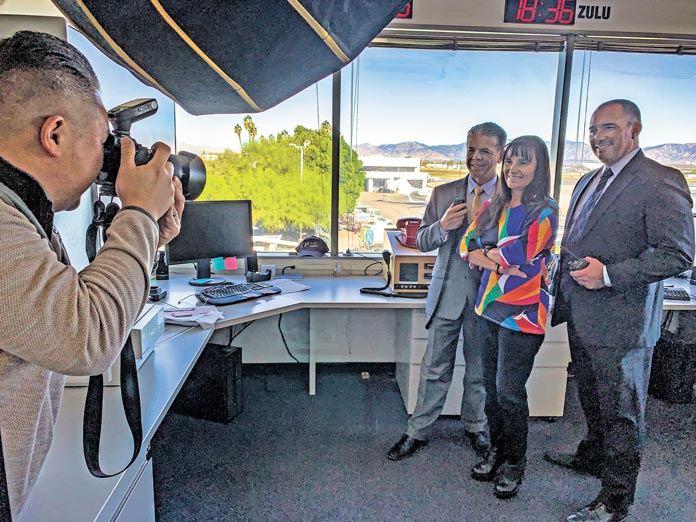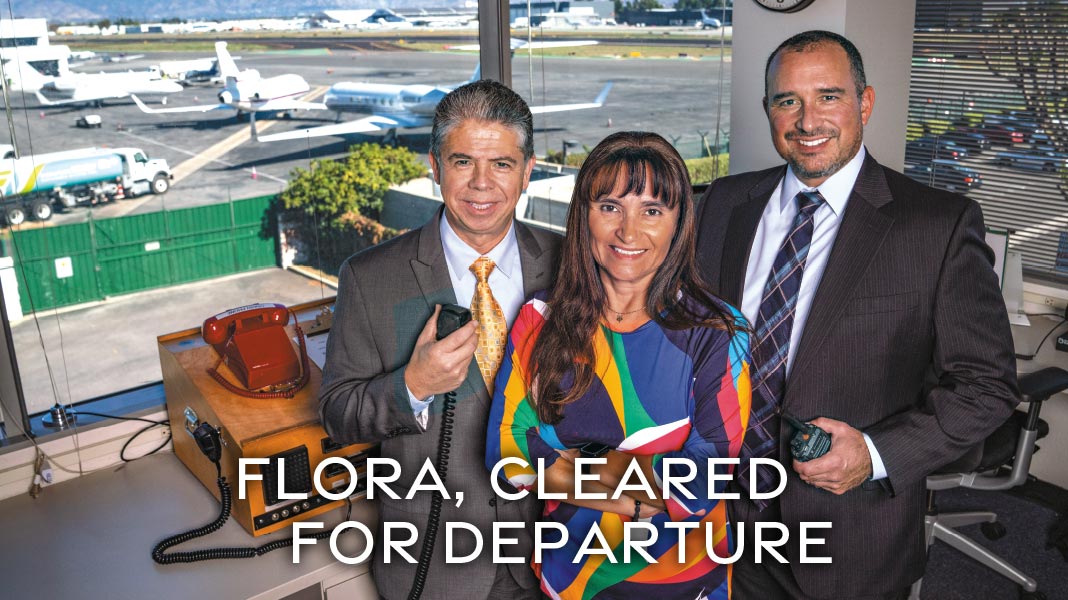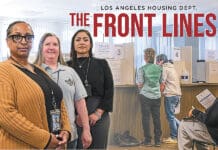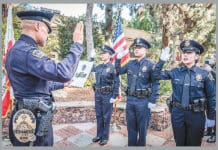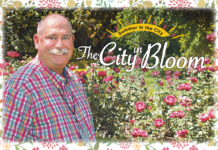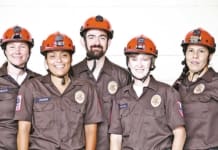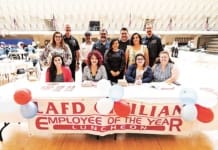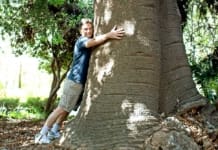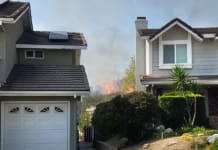
Photos by Summy Lam, Club VP of Marketing, With the world-class improvements going on at LAX – nothing short of a transformation is taking place, as we have chronicled – there is plenty of positive news coming out of Airports, and will continue to do so. That includes Van Nuys Airport, one of the country’s most important general aviation airports. The facility in the middle of the San Fernando Valley has seen major infrastructure projects being realized in the last few years, too, as it weathered the pandemic. Piloting that has been Flora Margheritis, Director of Airport Operations, Van Nuys Airport, 32 years of City service, who has announced her retirement for the end of this month. In this feature, Alive! chronicles her long career in aviation; the work she has led to improve the airport; the ties to the community she has built; and her thoughts on the future of general and business aviation in Los Angeles. Join us as we celebrate the career of an aviation administration giant, Flora Margheritis. ‘A DREAM FULFILLED’ On Oct. 6, Club CEO Robert Larios and Alive! editor John Burnes interviewed the leadership team at Van Nuys Airport – Flora Margheritis (center), Director of Van Nuys Airport, 32 years of City service; Paul Herrera (left), Airport Manager, 23 years, Club Member; and Christian Moreno (right), Chief of Airport Operations, 18 years, Club Member. The interview was held via Zoom and was in anticipation of Flora’s retirement at the end of January. Thanks for joining us today, as we get ready to bid farewell to Flora, who’s retiring in a few months. Flora Margheritis: Sure! We love talking about Van Nuys Airport. Not too many folks know how great the airport is. This is a golden opportunity. So thank you. Of course. We’d like to start by asking how you attained the job and position. With Flora’s impending retirement, that will be especially important to journal. Flora: I’ll try to keep it short. I’ve been asked that many times through the course of my career. I like to tell my story because it takes me back to my childhood. Sounds interesting! Flora: When I was about eight years old, I paid a visit to Mexico City’s International Airport where my uncle was executive director at the time. On a family visit I remember going to his office and being very impressed with the fact that you could look outside the window and see airplanes and runways. That left an impression in my mind. Curiosity got the best of me when I was trying to figure out how on earth an airplane could fly. I was flying back and forth between LA and Mexico City at the time on a 747; I couldn’t understand how such a heavy machine could maintain flight in the air. Being the curious bug that I was, I wanted to figure it out. When I was 13 or 14, I took an interest in aerodynamics and wanted to know how an airplane flew. That led to me wanting to take flying lessons; I started taking flying lessons when I was 15. I actually earned my private pilot certificate before I earned my driver’s license, or maybe right around the same time. I always knew that something in airports or aviation would be the career for me. That’s when I set my aviation path at a very young age. And once I earned my private pilot’s certificate, I had my sights set on getting my first real aviation job at an airport somewhere. Right. Were you instrument-rated when you were that young? How high was your license? Flora: No, just a private pilot certificate. I did start my instrument rating, although I never completed it. Being a recreational pilot is what I wanted to do first; I wasn’t too interested in flying in inclement weather. Got it. Keep going. Flora: I did think about how great it would be to be a commercial pilot and maybe go down that path, but for one reason or the other I decided not to pursue it. I wanted a job at an airport, and I kept thinking back to my uncle’s office. How can I get an airport office some day? You certainly got that! That’s where we photographed you on the cover. Flora: Right, you look out the window and see aircraft and runways. That’s a dream fulfilled, as far as I’m concerned. But anyway, my very first job at an airport – and I laugh at this, although it was wonderful – was at the Burbank Airport gift shop. But I had a strategy; I had a plan. I wanted a job with the airlines or airport in some capacity. I figured, if I get this job at the airport gift shop selling cigarettes, candy and gum, eventually I’m going to meet a manager where I could demonstrate these great customer service skills that I have. I hoped that would lead me into an aviation job. Did it? Flora: That’s exactly what happened. It didn’t lead me into an airline job, but it led me into a job at an FBO. An FBO is an acronym for Fixed-Base Operator. The FBO manager at one… of the FBOs at Burbank Airport at the time, Martin Aviation, offered me a job because he was impressed by my customer service skills. So I worked at Martin Aviation for six years. That was a true aviation job; I was providing services to aircraft operators – selling fuel, taking their catering order, setting up their ground transportation, and offering all kinds of aeronautical services. That was an excellent job. Not only did it allow me to pursue my education in aviation – we were allowed to do our homework during slow times – but learning the business side of aviation was really helpful to me. I focused on getting an actual degree in aviation management or airport management. I earned my associates degrees at Glendale Community College in airport administration and pilot training. With those degrees, I transferred to Cal State LA, which offered a bachelor’s degree in aviation administration, which I earned. A colleague mentioned to me that the City of L.A. managed four airports (at the time). I was getting close to graduation; I made a simple phone call to one of the high-level managers, Jerry Lee, at LAX and asked if he could help me – were there any internship opportunities? He communicated to an airport superintendent that I needed a job in airport operations. “Let’s make it happen,” he said. That’s how I got an internship position at LAX for the Department of Airports. Today that position is called a Student Professional Worker. It’s an excellent opportunity to get started at the airport. Once I was at LAX, I learned about the Civil Service process to get a full-time job. I had my bachelor’s degree, so I was eligible to take the exam for an Airport Operations Coordinator and was lucky enough to land at the top of the list to be called for an opportunity to join the City. So when the opportunity came up where there were open positions available at LAX, I was already an intern learning about several divisions at LAX – engineering, public relations, maintenance, police and risk management. I learned about how all the pieces of the puzzle worked together to run the airport. With all of that experience and my degree, I earned my first real government civil service airport job in February 1993 as an entry-level Airport Operations Coordinator. From there, I was promoted to different levels as an Airport Superintendent of Operations. I was promoted to a Superintendent II, then to a III. I spent 17 years of my career at Los Angeles International Airport prior to coming out to Van Nuys; that came in 2008 when an opportunity opened up at Van Nuys Airport. The Van Nuys Airport was hiring for a Chief of Airport Operations, so I was promoted into that position. I was the Chief of Operations for eight years, focusing on safety compliance of the airport, overseeing staff who were responsible for making sure that we ran a safe airport in compliance with federal, state and local regulations. While I did that for eight years, I learned a lot watching and learning from the previous airport managers, learning how they handled everything – the issues, the challenges, the stakeholder interests, the politics – you name it. When the opportunity came to step into the Airport Manager position in 2016 – I accepted that role and have been the Airport Manager ever since. In my final year, I was promoted to Director of Operations. But my primary function was to continue to manage Van Nuys Airport, one of the busiest general aviation airports in the world. That is my story! Quite a story! Christian, how about you? Christian Moreno: My dad was in aviation. Airshows were the thing to do when I was a kid. I went to the Rialto Airport and met Art Shaw. He was an aviator. There was a small group there called the Civil Air Patrol, which managed a small cadet program there, which I joined. Art Shaw gave me my first logbook. It has his signature on it, which is kind of cool in today’s world. I stayed on that trajectory. I wanted to become a commercial pilot, but I didn’t know how to do that. I became a pilot at 16 at Torrance Airport. I received my IFR at Brackett Field in Pomona. I joined the airlines back in 1989; I’m one of the last employees with Pan Am Airways. I was with Pan Am at Terminal 2 at LAX at that time. Pan Am left, of course. I moved around with the airlines until I got the opportunity to work with the City in Airport Operations, managing aircraft parking positions (gates). That was in 2004. The Airport Manager at that time decided that all Coordinators and Superintendent I’s should be out on the airfield. That’s how I got my taste out on the airfield itself, driving around between airplanes. I loved every second of it. I moved to Van Nuys as a Superintendent II. I worked for Flora when she was a chief here, then I was promoted back to LAX as the terminal manager at the Tom Bradley International Terminal. I did that for three years, and I worked with all the airlines. I came back here as a Chief of Airport Operations working for Flora again. This is round number two for me in separate roles working for Van Nuys Airport. Was that the original Pan Am? Or the second version? Christian: It was the second. We still have some folks who were there for many, many years. Great. Paul, how about you? Paul Herrera: I was born and raised in Santa Monica. I learned how to fly with a scholarship from the Santa Monica Airport Association that encouraged high school students to put their name in the hat for consideration to get a private pilot certificate. I was fortunate enough to also land a job there at Tantalizing Takeoffs, a pilot supply shop that allowed me to get a flavor of what aviation was all about. I learned a lot from the Noise Officer there, Jason Morgan, who gave me a pamphlet about the Federal Aviation Regulations – Part 139, which described how to run an airport – it’s our bible on how airports are supposed to be maintained and regulated for commercial service. Through that high school scholarship opportunity, I found jobs at the Santa Monica Airport refueling and washing airplanes as a young kid. I worked at Justice Aviation for Joe and Sharon Justice and then got a job at Burbank Airport in the late 1990s. I experienced a significant aircraft accident while working there – a Southwest Airlines Boeing 737 overshot the runway and went through the blast fence there in the late ’90s. Through that experience in emergency operations and just being in the thick of it, I continued to learn about this fascinating industry and the super dynamic growth in air travel. I joined LAWA in 2008. Like Flora and Christian, I was fortunate enough to get different opportunities at LAWA on a variety of different projects and programs. I found strong interests in emergency management, emergency operations, customer service and working with the terminal operations team on a variety of different aviation topics. I’ve been able to come back to the roots of general aviation and propeller-driven aircraft here at the Van Nuys Airport compared to Los Angeles International Airport. I’m super excited to continue the good work that Christian and Flora have done all these years. It sounds to me like we have three people who not only work in aviation, but who also live and breathe it. All three of you were in aviation before you ever worked for the City. Paul: Right. Flora, you’re retiring soon. Talk about the progress of the airport since you began. Flora: I started at Van Nuys Airport in July 2008, and I’ve been the Manager since 2016. The progress has been tremendous. We’ve invested more than $100 million in capital projects, including the investments the tenants have made. We’ve invested in our runways, our taxiways, taxi lanes – the core infrastructure. The tenant investments have been in their facilities, their hangers, their private terminals, and other facilities. I’ve seen so much investment in the years I’ve been here at Van Nuys. But also what’s different – when I got here in 2008, there wasn’t this tremendous focus on sustainability and environmentalism. We are very focused on these elements today. We recognize that there are impacts to our neighbors, and we invest significantly in programs to try and reduce our carbon footprint. For example, our tenants have invested a lot in solar projects; there are more rooftop solar panels here at Van Nuys than at any other general aviation airport, at least in the state, if not broader. Our facilities are being built in a very green way. Many of our tenants are seeking LEED [green building] certification. We’re seeing so much on the environmental/sustainability front. Van Nuys Airport now offers Sustainable Alternative Jet Fuel, unleaded gasoline for piston-powered aircraft, and renewable diesel fuel. Van Nuys Airport is a national leader in environmental sustainability due to the collective efforts of our tenants. That’s what’s happening here. What will you be most proud of? Flora: At the top of the list will be the partnerships and the relationships I’ve built with all of the Van Nuys Airport stakeholders. By stakeholders, I’m talking about everybody – my airport staff, airport tenants, our government and business partners, our neighbors, our communities, our elected officials, and their staff. Those strong partnerships and relationships make me very proud and without them doing my job would have been very hard. Speaking of my staff – LAWA has a lot of employees. And almost 60 of them work here at the Van Nuys Airport. We’re talking about police, operations, maintenance, and our administrative folks. We have one electrician out here, one plumber. We have a Maintenance Supervisor, a painter, and custodians. We have public relations staff out here. Collectively we’re one team here and everybody has the common goal of making this airport one of the best general aviation airports in the country. Van Nuys Airport is L.A.’s premier business airport. I’m very proud of my staff. Community relations has to be a big part of the growth. Flora: Yes. That’s a big part of my job. My number one job here, as it relates to the community, is work collaboratively, and to express to the community the value that the airport brings. Cities and counties are more successful when they have an airport, and the value that we bring in terms of the jobs and the economic impact is tremendous. But before we move on, I want to make sure I mention how exceptional our employees were during the pandemic. Sure. Flora: We had never been through a pandemic. This airport had never experienced that. It’s important to mention the resilience and the strength of all of the employees who work at the airport, not just the LAWA employees but our airport tenants, too. Their commitment to their jobs to get us through this was amazing. It was a stressful time, but through it all they kept the airport going, and we played a significant role in the City’s economic recovery. We learned a lot of lessons on how to handle things, and I feel we’re ready if another one comes. We recovered a lot quicker than other businesses. For that, I’m very proud. Is there any way to quantify the development of Van Nuys since you started? And how did the pandemic affect your business? Flora: When we talk about growth, we focus on airport operations, defined as takeoffs and landings. Van Nuys actually used to have a lot more takeoffs and landings than we are doing today. Our highest number of operations occurred in the mid ’90s when the airport was doing more than 600,000 operations annually. That’s a lot of operations. But that airport was a different airport. It catered more to propeller aircraft; it was not the business aviation airport that it is today. I wasn’t here then. Also, this airport has always been a very popular airport to conduct flight training. Every time you do flight training, and you conduct a touch and go operation, that drives up the operational count. Today there are more than 300,000 operations annually. We’ve gone from that 600,000 down to 300,000 operations because we’ve seen a decline in general aviation aircraft operations typically conducted by propeller aircraft. We’re seeing an increase in jet operations, but we are still seeing a lot more propeller aircraft takeoffs and landings than we are jet operations. A lot of the propeller traffic has moved to other airports. One thing that I do see at Van Nuys is the impact on the economy. When the economy’s doing great, we see a lot more takeoffs and landings. The economy went down for a while. Back in 2015 and 2016, we dipped down to the low 200,000s. We are at more than 300,000 operations today and climbing. We’re getting busier. The pandemic was very, very impactful. I’ve never been through a pandemic, and what I saw in April 2020 I hope Van Nuys never sees again; we had an 80 percent drop in takeoffs and landings. You can imagine how hurtful that was to our businesses, to our users, to LAWA, to the City. But we recovered quickly. Travelers who can afford it discovered the convenience of flying business aviation and chartering a jet. Travelers did not want to fly commercial airlines throughout the pandemic for different reasons, including health concerns and because of the rules that were always changing. They turned to business aviation where there was a lot more flexibility, a lot more privacy, a lot fewer restrictions. A question for Christian and Paul, and we know she’ listening: Talk about Flora’s leadership. Flora: Make it good! What impresses you the most? Christian: It’s the way she manages the variety of complex matters that impacts this airport. There’s always something happening out here. She has a depth of knowledge gained throughout her career that is remarkable. Her ability to recall and deliver information to our stakeholders, to the community, to elected officials is really impressive. Flora has a skill in being able to understand her audience and deliver information that can be quite complicated. She knows how to explain complex matters in a simple way. She identifies resources that are available and will speak to our stakeholders and community members with confidence. Paul: Flora has done an outstanding job in being a caretaker of this great San Fernando Valley airport. I’m truly impressed by the wealth of knowledge and information that she can recite. You can ask her just about any question from sustainability, to infrastructure, to local government and politics, the surrounding communities, and she’s really a walking encyclopedia. I have big shoes to fill. I am grateful for the opportunity to continue this trajectory that we are on, but Flora leaves a wake behind her as she departs with an incredible depth of knowledge and experience. Paul, you’ll be in charge. Where is the airport going from here? Paul: It’s an exciting time. I’m thrilled. There’s a positive future on its horizon. But as Flora has pointed out, it’s a new era. I’m grateful that Christian is going to help shepherd me along as I make the transition. He has a lot of experience and knowledge of this great airport for the last 10 years or so, if not more. I’m looking forward to it. There are a number of topics that we can talk about. But the focus is to make sure that Van Nuys Airport maintains its premier status as a gold standard airport, and being the airport of choice especially here in Southern California. I know that the Los Angeles Green New Deal has a lot of focus as we look to sustainability initiatives. This will encourage thought-provoking discussions on renewable energy and zero emission policies that the City of Los Angeles wants to lead in. It’s our job to amplify these initiatives and to encourage stakeholders to participate in these topics so that we can lead the industry and set the new sort of expectation of how we can do better and be a better neighbor. I’m definitely focused on sustainability and all the good it brings to our community. Safety and security are at the forefront of how we need to be a caretaker of this great land. I am encouraged by the Airport Land Use Plan and how it provides a blueprint of what should be considered in the various areas of the airport. This plan could help us be mindful of the airports future and its development. We are having some really deep and great discussions internally on how to have a vision for this wonderful airport as we go into the next set of years. I’m very much involved with our future plan that was developed back in 2005, and working with our teams of engineers, architects and folks in the environmental group, as well as community relations and public relations folks on how to tell the story of where we have been and where we would like to go from here. And something that’s really exciting for us aviators is urban air mobility and how it’s going to really shape the future of aviation. These are what appear to be traditional helicopters that could be used in a variety of ways through electrification. It is clear that urban air mobility and unmanned aircraft will soon be a method of transportation for goods and people who want to get around in a environmentally friendly aircraft. It’s going to be fun to see how The Jetsons really comes full circle from when we were kids to what potentially could happen in our generation and what we could do in the airspace with these emerging technologies. Finally, for Angelenos, I think we are all really excited about upcoming events in Los Angeles with the College National Championships, the next FIFA World Cup and the 2028 Summer Olympics. These are all fantastic world events that are coming to Los Angeles, and what better asset than a vibrant general aviation airport that packs a punch with the number of operations that brings business and opportunity to the City of Los Angeles. It’s a true treasure with what we have in our City. Christian and I have a lot ahead of us. We have big shoes to fill with Flora’s departure. We are excited for the future of the Van Nuys Airport. I’m really looking forward to the challenges that are ahead and the opportunities to care for this airport as good as she has done for all these years. Having said all that, there is a rich history that exists here that should not be forgotten. From Casablanca and movies that were filmed here, we still have a pretty thriving film industry that continues to exist here at the Van Nuys Airport, to the backbone of the war effort and the manufacturing of aircraft that supported the war efforts. Van Nuys was deeply involved in World War II – P-38 pilots came here to learn how to fly and participate in the war effort. Marilyn Monroe was discovered here – Ronald Reagan sent a photographer to one of the warehouses to capture women who were involved in the war efforts at the time and on the assembly lines. A photo of Marilyn Monroe was taken; the rest is history. I didn’t know that. Paul: Speaking of history, I should mention the Condor Squadron. It’s a unique nonprofit organization founded in 1965 by a group of World War II fighter pilots. During holiday events, they fly their A6 Texans over the City. They’re preserving a piece of aviation history along with the rich past of the Van Nuys Airport. We all respect and appreciate what they do to remember those that made the ultimate sacrifice. They’re a true treasure for our City and our airport. Christian: The Los Angeles Unified School District (LAUSD) has an affordable mechanic school here at the airport, and not many people know that. The LAUSD program here is a fraction of the cost. We’ve got to make sure that we keep our kids interested in different options within this field of work. The mechanic school is definitely an option to seek an interest and develop a skillset as an Airframe and Powerplant mechanic. It’s located on the west side of the airport and conveniently located to residents in the community. Paul: Van Nuys has a really fascinating history, and also a fascinating future. Flora: Our Van Nuys Airport webpage highlights a lot of the awesome history tied to this airport, going back to 1928 when it first started and was established as an airport. From Manager to Customer Flora: Speaking of the future, I’m going from manager to user. I’m a private pilot and aircraft owner. My husband and I own a small airplane that we keep over at the Whiteman Airport. He’s a private pilot as well. Aviation just really runs in our family. I’ll be able to fly in to the airport to see the great things Paul and Christian will be doing after I leave. For the record, who’s your husband? Flora: Alex Margheritis, the Airport Superintendent of Operations at LAX. Both aviators. Both City employees. There are a lot of parallels. Flora: Right. You just launched the rebuilt runway. Flora: It’s a very significant runway – so significant that there is a movie named after it, Runway One Six Right. You ought to see it some time. It really captures the history and tells the story of the Van Nuys Airport in a very special way. I have. Flora: The runway was a major slurry seal project and a significant investment in our infrastructure at the airport. In the world of general aviation airports, Van Nuys is known as a world-class airport and is LA’s business airport. When you start talking about general aviation airports, you’re always hearing about Van Nuys and Teterboro [outside New York City in New Jersey]. Investing in our runways allows us to maintain our world-class status. It maximizes operational safety. We improved our runways with new pavement, state-of-the-art LED lights, new signage, new markings and a new look. All of that translates into much safer runways. This investment in our runways gives us an excellent infrastructure and we’re good for 20 years with it. Both runways were funded with federal funds, and we need to make sure that Runway One Six Left lasts for 20 years, and One Six Right for another ten years before we can get federal funding for those projects again. For a number of reasons, small urban airports everywhere are under fire. How important is it that Van Nuys Airport continues to thrive? Flora: It’s extremely important. I hear what’s going on in the industry, with communities wanting to close down their airports because of noise and other environmental impacts. What the communities often don’t understand is the economic impact that an airport brings to its community. In the case of Van Nuys, the last economic impact study that we did in 2015-16 showed that the airport contributes more than $2 billion [annually] to the region. We are responsible for more than 10,000 jobs. There are about 5,200 employees who call Van Nuys Airport home. Even though only 60 of us work for LAWA, the remainder works for the more than 100 private businesses here. Imagine if the airport went away, and what that would do to jobs and to the economy. It would be very impactful. Unfortunately, general aviation airports often are often perceived as airports for the rich, the one-percenters flying or chartering their private jets. But there’s another important side – we are important for fire, police, air ambulance and public safety aircraft. A lot of our activity is directly tied to that. During the 1994 earthquake, this airport played a significant role in serving relief flights for the communities, all the flights to bring supplies to the communities that were very impacted. And that is Van Nuys’ job, to serve the community critically. Van Nuys Airport plays a key role in the community. We provide flights to patients in need of medical care and provide aircraft facilities for our local, state and federal law enforcement agencies. Also, the flight training conducted here helps keep a steady supply of pilots available for our airlines and military. Currently, there is a pilot shortage, and Van Nuys Airport is playing a major role in ensuring the availability of well-trained pilots. Paul: Right now the industry is experiencing a significant pilot shortage. Most pilots who find their way into a cockpit is because they have found their way to an airport for flight training. Every pilot flying for Delta, United, American and Southwest found their way to those great companies by first flying a smaller propeller-driven aircraft. It’s important for the San Fernando Valley to continue to provide an opportunity for pilots to be trained and to support the air transportation system in this manner. Having Van Nuys Airport allows for folks to learn and get involved in aviation and encourages young kids to become interested in this field of work. We hope that one day they too will find a career in aviation. It’s important that Van Nuys continues to be a resource and presence in the community, and to provide training that is desperately needed. Christian: We just had the “SuperScoopers” out here for fire prevention. LA County Fire was out here for fire season as usual, which plays a very big role in the region for fire protection. It’s significant where they are, strategically placed, next to these mountains, just north of us. That’s a huge benefit to all of us in having them so close. What do you love about what you do? And Flora, what will you miss? Flora: The passion. If you have a passion for something, do you really call it work? That’s how I feel about aviation and airports. They always say that if you love what you do, it’s not really work. Right? That holds true. I was just mentioning to Paul and Christian this morning that I actually like the smell of jet fuel. I don’t know if that’s weird or not, but I do. I love watching airplanes take off and land. That’s probably something that I will miss in my retirement – watching the takeoffs and landings every day. I’ll still be doing some flying on my own, but not every day. It’s going to be kind of strange for me to not be able to look out of my office window and watch an aircraft take flight. But this passion isn’t going to die with me; I hold it very close to my heart. Christian: If I had my way, I would be outside watching every landing and takeoff. And I’m not talking about jets exclusively: I would go to the small runway and watch the students take flight. We have an instructors’ bench out there – when the instructor believes that the student is ready to fly solo, they’ll pull over to this bench, get out, and tell the student that he or she is going to solo. I’ve experienced it. We’ve all experienced it as pilots. Anybody who’s had a license has experienced it. Seeing the reaction on the pilot’s face as they do their first takeoff and landing, by themselves, is really special. With the added workload and areas of responsibility, I’m more in the office nowadays, but I have a nice, beautiful window, right behind me in my office, and I’m always looking to see and hear the pilots take flight and depart to their destinations across the globe. Once a pilot, always a pilot. Great phrase. Paul: Whether at Los Angeles International Airport or Van Nuys Airport, my job connects people, and the work allows me to see the connection in business. Our work at Airports creates opportunities for people all over the world to be connected, employed and have an ability to put food on the table with good paying jobs. Being able to work and be part of this connection is really fantastic. There are so many emerging technologies that will be fascinating to watch. And also, I think for many aviation nuts like the three of us, we have seen Top Gun and the latest, Top Gun: Maverick. It’s the feeling of being in the cockpit, quietly pushing the envelope of the unknown, moving the throttle forward, even if for a few seconds to do what has not been done that touches home with all of us. Airport operations is our origin and destination that ties the route together. It’s so much fun to be part of it, and to contribute where we can. The mystique of flight is beautiful, interesting and thought-provoking. I’m super excited to be in this giant playground of people, aircraft and the beauty of flight. Flora, Christian and Paul, thank you very much for this chat, and for all you do for the City of LA. Of course, Flora, we wish you the best in your retirement. You’ve earned it! Flora: Thank you, Robert and John. BEHIND THE SCENES Club VP of Marketing Summy Lam photographs Flora Margheritis (center), Christian Moreno (left) and Paul Herrera in the operations room above Van Nuys Airport.Flora Margheritis, Director of Airport Operations at Van Nuys, retires after piloting the general aviation facility into clear skies ahead.
and courtesy Airports and Flora Margheritis
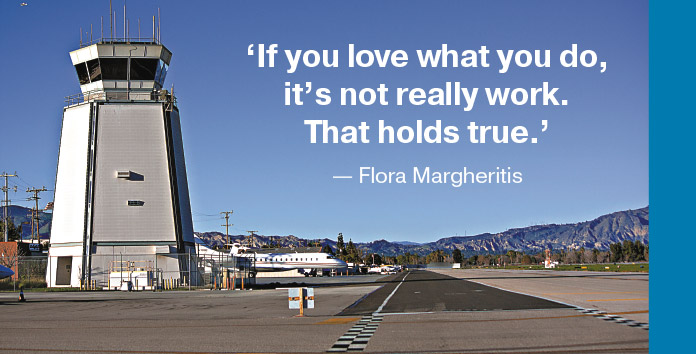



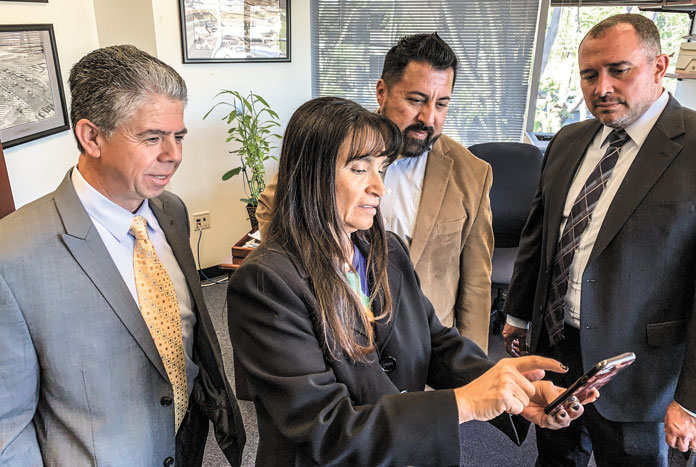
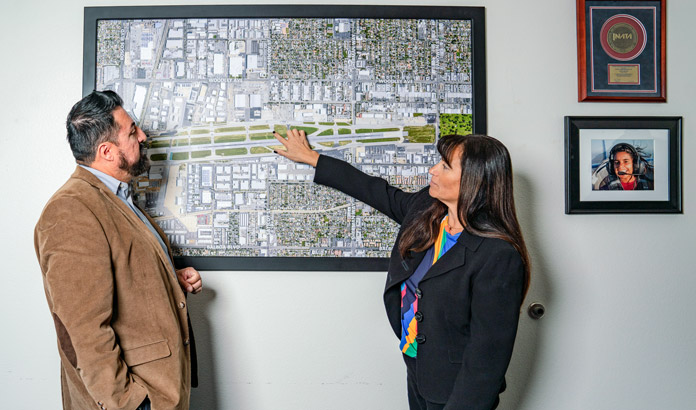
 A Better, Greener Airport
A Better, Greener Airport
 Transition of Flight Types
Transition of Flight Types Leadership
Leadership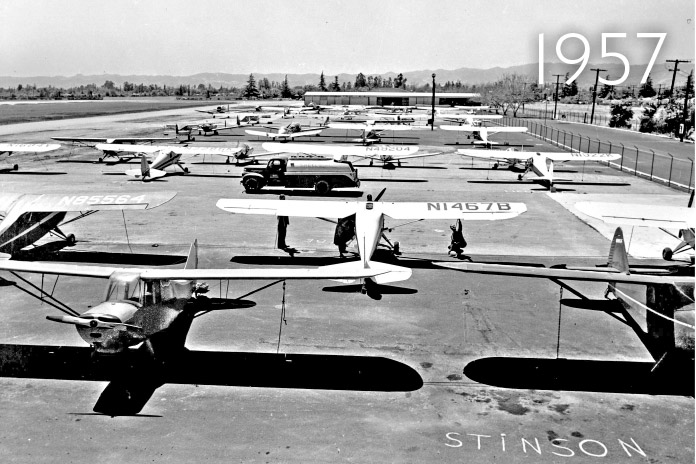
 The Future Van Nuys
The Future Van Nuys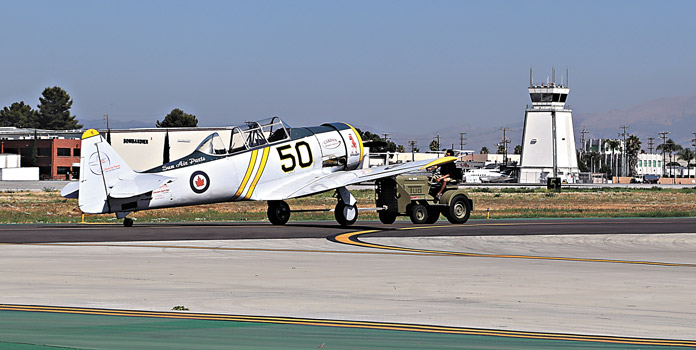

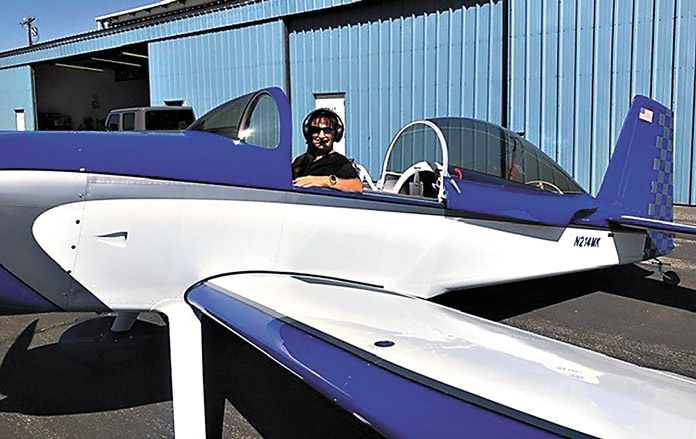
 One-Six Right
One-Six Right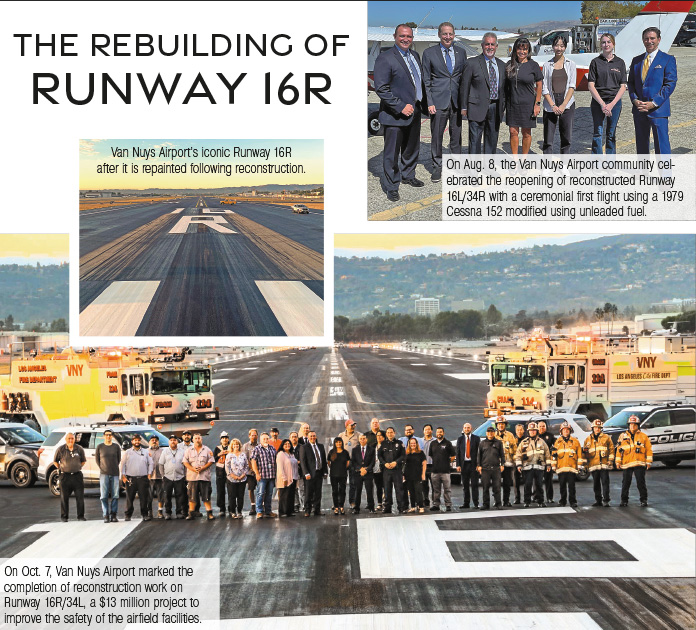
 Needed and Necessary
Needed and Necessary
 The Mystique of Flight
The Mystique of Flight
